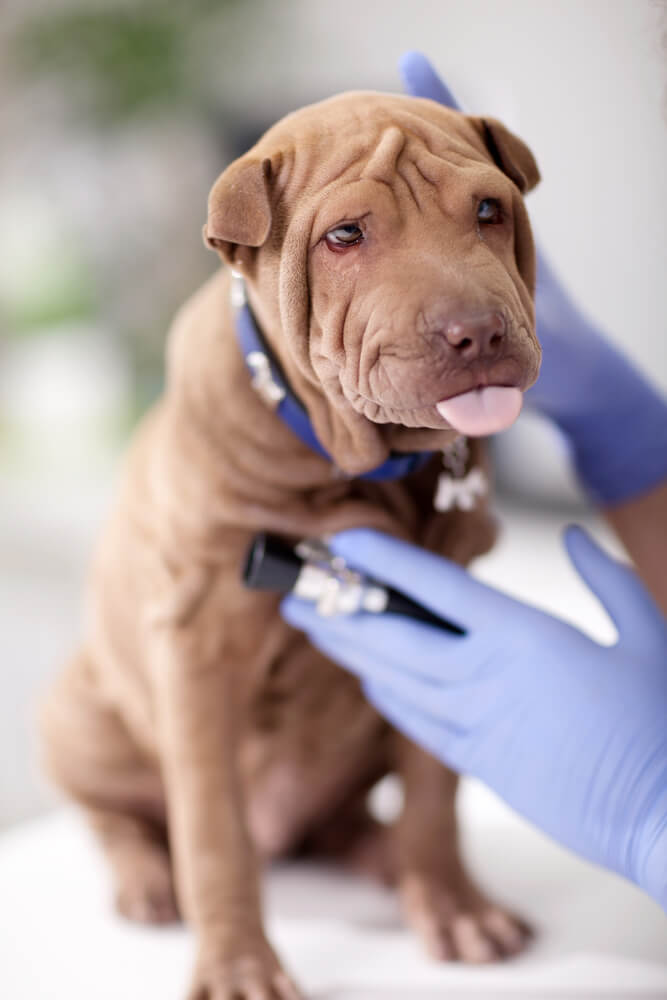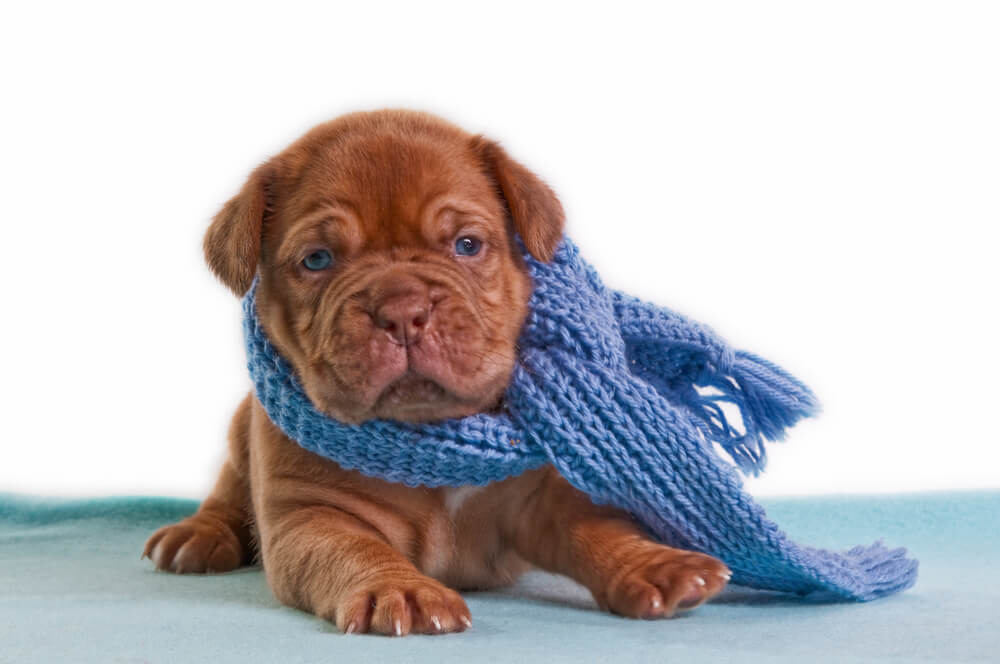Do you have a Shar Pei? If so, you know that they’re one of the most loving and protective dog breeds out there. But did you know that they’re also prone to certain health conditions?
In this blog post, we’ll discuss some signs that your Shar Pei dogs may be in pain and how you can help them feel better. Keep reading to learn more!
Understanding the Breed-Specific Health Conditions in Shar-Peis
Shar-Peis, while being distinctive and charming breeds, are prone to some specific health conditions. One of the most common is a condition known as Familial Shar Pei Fever (FSF).
This is a hereditary inflammatory disorder that leads to short, recurrent fever, episodes of fever and swelling in the hocks. Another condition Shar Peis are predisposed to is hip and elbow dysplasia, which could lead to your dog limping or showing reluctance to move or jump.
Also, their unique skin folds make them more prone to skin conditions such as bacterial infections. Being aware of these breed-specific health conditions can help you better understand and address any discomfort your Shar Pei may be experiencing.
The Link Between Behavioral Changes and Pain in Dogs
Dogs are experts at hiding pain, a trait passed down from their ancestors who needed to mask pain to avoid appearing weak to predators. As a result, one of the main ways dogs express discomfort is through changes in behavior.
If your Shar Pei is usually playful and energetic but starts to become more lethargic or shows aggression, it might be a sign of pain. Other changes could include a decreased appetite, excessive licking or chewing of a particular area, or increased levels of anxiety.
Recognizing these changes in your dog’s behavior can help you identify when they might be in pain and need a visit to the vet.

Tips for Preventing Common Health Problems in Shar Peis
Preventing health issues is always better than treating them. Regular exercise and a balanced diet can keep your Shar Pei healthy and prevent many common health problems. Obesity can exacerbate conditions like hip dysplasia, so maintaining a healthy weight is crucial.
Regular grooming can help prevent skin infections, and cleaning their ears can prevent ear infections, another common problem due to their folded skin. Also, regular dental care is important as dental disease can lead to other health problems.
Finally, due to their predisposition to certain genetic conditions, buying from a reputable breeder who tests their dogs for these conditions can help avoid them.
Exploring the Role of Exercise and Nutrition in Your Shar Pei’s Health
A balanced diet and regular exercise play a vital role in the overall health and wellbeing of your Shar Pei. Exercise not only helps to maintain a healthy weight, but it also keeps your dog’s joints flexible and strengthens their muscles.
Similarly, a balanced diet ensures that your dog is getting all the necessary nutrients they need to keep its immune system strong and its body functioning properly. It’s also crucial to feed your Shar Pei a diet that’s appropriate for their age, size, and health status.
Your vet can provide personalized advice on the best diet and exercise regimen for your furry friend.
The Importance of Regular Vet Check-Ups for Your Shar Pei
Just like humans, dogs require regular health check-ups to maintain optimal health. Regular vet visits can catch potential health issues before they become serious problems. During a check-up, a vet will typically examine your dog’s body for any abnormal signs, listen to their heart and lungs, and might recommend blood tests, urine tests, or X-rays if necessary.
Regular dental checks and vaccinations are also crucial to prevent various diseases. For Shar Peis, vet check-ups also provide an opportunity to check their skin and ears for any signs of infection, which can be common in this breed due to their characteristic skin folds.
Using Physical Therapy to Alleviate Your Dog’s Pain
Physical therapy can be a great non-invasive way to manage pain in dogs. It can be particularly helpful for dogs suffering from conditions like hip dysplasia or arthritis, or recovering from an injury or surgery. Physical therapy techniques such as massage, passive range of motion exercises, and balance exercises
can all help improve your dog’s mobility, strengthen their muscles, and alleviate pain. Hydrotherapy, which involves exercises in water, can also be an excellent low-impact form of exercise that’s gentle on your dog’s joints. Remember, any form of physical therapy should be conducted under the supervision of a professional to ensure it’s being done correctly and safely.

Alternative Methods for Pain Relief in Dogs: Acupuncture and Hydrotherapy
Alternative therapies such as acupuncture and hydrotherapy are gaining popularity in the field of veterinary medicine for their effectiveness in managing pain. Acupuncture involves inserting needles into specific points on the body to stimulate the nervous system and promote healing.
It’s been found to be especially effective for managing arthritis, hip dysplasia, and other musculoskeletal conditions. On the other hand, hydrotherapy (water therapy) allows dogs to exercise their muscles and joints without the stress of their full body weight, making it a great option for dogs with arthritis, hip dysplasia, or those recovering from surgery.
Holistic Approaches to Shar Pei Health: Pros and Cons
Holistic approaches to health consider the whole animal – not just the physical body but also the mind and spirit. They can include practices like acupuncture, herbal medicine, homeopathy, and even energy healing modalities like Reiki.
The benefits of these methods are that they tend to have fewer side effects than conventional medicine and can be very effective for some conditions. However, the evidence supporting these methods is often anecdotal and they may not be as effective for acute or severe conditions.
It’s important to have a discussion with your vet about the best approach for your Shar Pei’s specific needs and circumstances.
Shar Pei’s Special Skin: Identifying Skin Issues and Providing Care
One of the distinctive features of Shar Peis is their wrinkled skin. While this certainly adds to their charm, it can also predispose them to certain skin issues. Their skin folds can trap moisture and bacteria, leading to infections if not cleaned regularly.
They can also be prone to skin conditions like pyoderma, dermatitis, and allergies. Regular grooming, including cleaning the folds, and a healthy diet can help maintain their skin health. If you notice any signs of skin issues, such as redness, itching, or a bad smell, it’s important to consult your vet as soon as possible.
Dealing with Aging and End-of-Life Care for Your Shar Pei
As Shar Peis age, they may face a variety of health issues, from arthritis to heart problems, and even cognitive decline. It’s important to provide them with a comfortable and supportive environment during this stage of their life.
This might involve modifying their diet and exercise regimen, providing additional comfort measures like orthopedic beds, and potentially starting them on medications to manage pain and other health conditions.
Your vet can help guide you through this process and ensure that your beloved pet is comfortable and cared for in their golden years.
How to Comfort Your Dog During a Painful Episode
Seeing your dog in pain can be distressing. However, there are several things you can do to provide comfort. Speak to your vet about appropriate pain medication. Create a quiet, comfortable space for your dog to rest.
Some dogs may appreciate gentle massages or soft petting, while others prefer to be left alone. Warm or cold compresses can help with some types of pain – just make sure to follow your vet’s instructions to avoid causing further discomfort.
Providing mental stimulation, like chew toys or puzzle feeders, can also be a good distraction from pain.

The Psychological Impact of Chronic Pain in Dogs
Chronic pain can have a significant impact on a dog’s mental wellbeing. Dogs in chronic pain can become anxious or depressed and may exhibit behavioral changes such as aggression or increased clinginess
. They might also lose interest in activities they once enjoyed. Chronic pain can disrupt their sleep, further exacerbating these behavioral changes. It’s important to recognize these signs and speak to your vet about them.
Pain management should encompass not only physical pain but also the mental and emotional aspects of pain. This might involve medication, behavioral therapy, environmental modifications, or a combination of these. Just like humans, dogs are complex creatures with a range of emotions, and it’s important to address their holistic needs to ensure they live a comfortable and fulfilling life.
Why is my Shar-Pei limping?
After noticing your Shar-Pei has been limping around, it’s understandable to feel worried. It’s important to figure out what might be causing the limping so you can help your pet as quickly as possible. Of course, an injury could be the culprit and is often easy to diagnose. However, joint and bone issues like hip dysplasia can lead to lameness in Shar-Peis.
Other causes of limping include arthritis, weakened muscles from lack of exercise, or even a foreign body stuck between the toes! Take your furry friend for a full checkup with your vet and ask lots of questions to get answers to specific questions about age-related changes and nutritional needs that may help inhibit further limping.
How do dogs show pain?
Dogs are incredible animals and they can show many different emotions. However, like humans, dogs may have difficulty expressing pain. Some signs of a dog hurting include panting or trembling, crying out when touched, behavior changes and they may become less active than usual.
Dogs who appear to be in pain will sometimes try to hide away from everyone, which is why it’s important to pay close attention and watch for any indication that your pooch might not be feeling well. Seeing a vet if abnormal behavior continues is the best way to ensure your furry friend is taken care of properly.
What are the warning signs your dog is crying for help?
It’s easy to overlook when our furry companions are trying to tell us something. As their owners, we need to recognize when our dogs are in distress and may be “crying for help” so that we can take the steps necessary to improve the situation.
Some of the key signs to keep an eye out for include dramatic changes in behavior such as suddenly being more aggressive or lethargic than usual, excessive barking, whining, or howling, or changes in appetite or sleep habits.
Additionally, look out for physical signs like unkempt fur and skin conditions, limping, shaking/shivering, heavy panting, or yawning. If you notice any of these signs in your beloved pup don’t hesitate to bring them to a vet who can recommend the proper course of action.

What can I give my dog in pain?
Taking care of a pet in pain is one of the most difficult situations for an animal lover to be faced with. There may be a lot of questions about what types of medications are safe and how best to provide relief.
However, some options can help keep your beloved pup comfortable. The first thing is to talk to your vet about what type of over-the-counter products if any, might relieve your dog’s discomfort. Never give any medication meant for humans or even other animals as it could be harmful to your pet.
You can also consider certain supplements such as glucosamine or chondroitin, in addition to ramps and steps to help them access places easier than jumping. Finally, try using cold and hot therapy on their joints and muscles;
however, make sure not to let the heat stay too long. With these methods, you are sure to make a difference in your furry friends’ day-to-day life and any painful discomfort they may be experiencing!
What home remedy can I give my dog for pain?
If your dog is in pain, there are a few things you can do to help them. One home remedy that may ease their discomfort is massage. Gently rub your pet in the areas where they feel sore and provide them with some relief. You could also try adding a heated pad or cushion near their sleeping area to offer extra comfort.
Dietary changes are always an option if you think your pup might be dealing with digestive issues that could be causing pain – perhaps switch to an easily digestible diet made of natural ingredients like real meat and vegetables, or check with your vet if other supplements would be beneficial.
Of course, always thoroughly check with your vet before implementing any changes to ensure that you’re providing the best possible care for your furry friend.
Conclusion
In conclusion, paying attention to your Shar-Pei’s body language and behavior can help you spot any signs they might be in pain. A few key things to look out for include changes in posture, vocalizations, excessive licking of certain areas, not wanting to move around or play as much, panting more often than usual, and a lack of appetite.
It’s always better to be proactive in taking your dog to the vet right away if you notice any of these warning signs.
Regular checkups with your veterinarian can also help make sure that they stay healthy and that any potential illnesses or injuries are caught before it’s too late. Additionally, always ask your vet about pain medications if needed – there are many options available that may help give your pup some relief.
Keeping an eye out for signs of discomfort thirst or distress is one way to ensure that your four-legged companion stays safe and happy for years to come!














